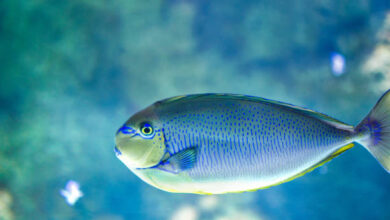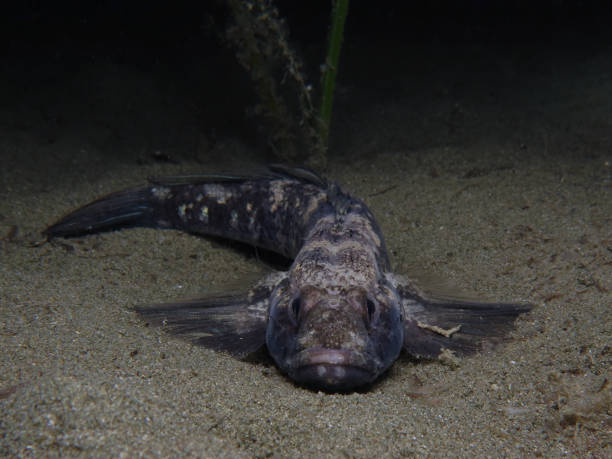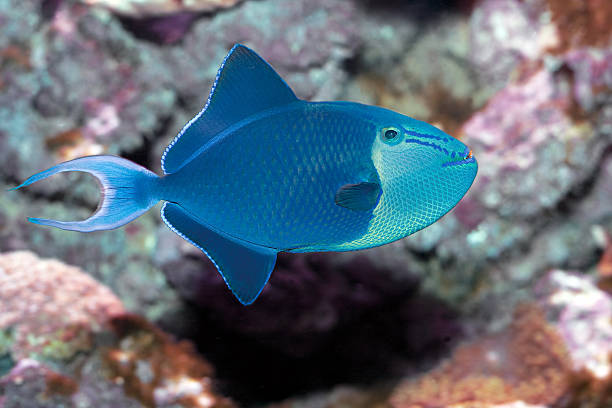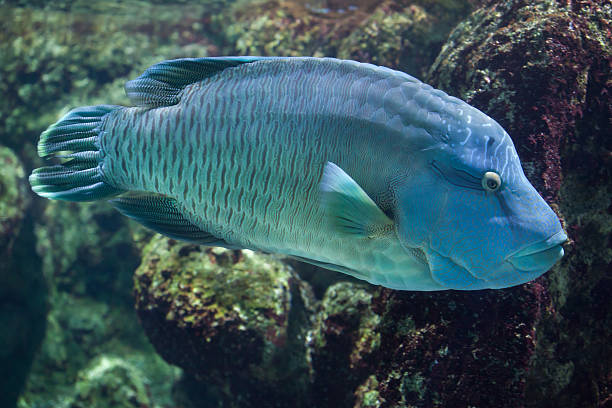What are some 10 examples of lobe-finned fish?

Lobe-finned fish are a unique and ancient group of aquatic animals that have been around for millions of years. These fish are characterized by their distinctive fins, which have a fleshy, lobed structure that resembles the limbs of land-dwelling vertebrates. While they may not be as well-known as other types of fish, lobe-finned fish play a crucial role in our understanding of evolution and the diversity of life on Earth. In this blog post, we will explore 10 fascinating examples of lobe-finned fish and learn more about these fascinating creatures.
Introduction to Lobe-Finned Fish
Welcome to the captivating world of lobe-finned fish, also known as Sarcopterygii. This extraordinary group of vertebrates boast distinctive lobed paired fins, unlike their counterparts in the fish kingdom. Their claim to fame in the scientific world, however, is their evolutionary lineage tracing back to terrestrial animals – an aspect that makes them a topic of avid research and study.
While extinction has claimed most species within this group, a handful have demonstrated incredible adaptability and resilience, persisting through millions of years. As we delve deeper into the world of lobe-finned fish, you’ll encounter remarkable creatures that are living testaments to evolution and survival. From their prehistoric past to their intriguing present, each lobe-finned fish species presents an engaging tale of survival and adaptation. Let’s dive in! One of the most iconic lobe-finned fish species is the coelacanth, a species once thought to be extinct.
Discovering the survival of these ‘living fossils’ has intrigued researchers worldwide, further piquing interest in this evolutionary marvel. This renewed focus on lobe-finned fish has ignited an array of new studies aimed at deciphering their secrets. Their ancient lineage provides a unique perspective on the evolution of life on Earth, enriching our understanding of the complexity and beauty of the natural world. As we peel back the layers of history, lobe-finned fish emerge as crucial connectors to our own terrestrial existence. Let’s now venture deeper into their world, unfolding the intricate connection between water and land dwellers.
Understanding the Coelacanth, lobe-finned fish?
Embark on a journey into the deep, blue sea as we delve into the enigmatic life of the coelacanth. These intriguing sea dwellers, previously assumed to have disappeared from the face of Earth 65 million years ago, resurfaced in 1938, much to the astonishment of the scientific community. The coelacanth, with its distinct lobed fins that move in a similar fashion to our arms and legs, offers a glimpse into an ancient era.
Unraveling the mysteries of their unique anatomy, from their thick scales to the electroreceptive rostral organ in their snouts, has been a captivating endeavor for scientists and fish enthusiasts alike. Their resistance to change over millions of years has earned them the title of ‘living fossils’. If you’re fascinated by creatures that tell a tale of time, the coelacanth surely won’t disappoint.
Despite its reputation as a creature from the prehistoric era, the coelacanth is very much a part of our present, continuing to thrive in the depths of our vast oceans. With every flip of their lobed fins, they bridge the gap between the Earth’s prehistoric past and the present.
Lungfish: The Air-Breathing Fish, lobe-finned fish?
Ready for another dive into the intriguing world of lobe-finned fish? Let’s turn our attention to the lungfish. Their unique name hints at their distinct biological feature – the ability to breathe air. This survival mechanism sets them apart from most fish species and cements their place in the lobe-finned family. Lungfish, unlike their aquatic cousins, boast of both gills and lungs.
This dual respiratory system allows them to thrive both in aquatic habitats and on terra firma. Each breath they take, whether underwater or on dry land, highlights the incredible adaptability of lobe-finned fish and paints a captivating picture of evolution in action. The lungfish’s ability to survive out of water is a testament to the survival capabilities of the lobe-finned family, as they continue to navigate the ebb and flow of changing environmental conditions.

Stay with us as we dive deeper to explore specific lungfish species and their unique traits in the following sections. One of these intriguing lobe-finned fish is the African lungfish, known for its extraordinary capacity to survive dry seasons. Our subsequent section will take an exciting turn into how this unique ability has influenced its habitat choices and behavioral adaptations. By exploring these characteristics, we hope to reveal even more about the diverse world of lobe-finned fish and their knack for adaptation.
So strap in as we journey from underwater forests to dusty plains, in our continued exploration of the versatile lungfish. Unraveling the secrets of these fascinating lobe-finned fish further elucidates our understanding of how diverse and flexible life forms can be. The tales of their survival and adaptations certainly make lungfish an emblem of biological resilience.
African Lungfish, lobe-finned fish?
Get ready for an expedition to the African waters, as we introduce you to the extraordinary African Lungfish. This lobe-finned marvel hails from the freshwater bodies of Africa, offering an impressive example of survival and adaptability. What sets the African lungfish apart from the crowd is its remarkable ability to endure dry spells. When faced with dry conditions, the African lungfish doesn’t just survive; it thrives.
It achieves this through an astounding biological feat – it forms a cocoon, burying itself in the mud and slipping into a state of dormancy. During this dormant phase, the African lungfish switches from breathing through gills to breathing air, patiently awaiting the return of more favorable conditions. When the dry season passes and the wet season arrives, these resilient creatures re-emerge, revitalized and ready to resume their aquatic existence. The African lungfish’s intriguing cocooning and dormant survival mechanism is a masterclass in resilience and adaptability, making it a fascinating specimen in the lobe-finned fish family.
Join us in marveling at this stunning testament to the power of evolution and survival in the face of adversity. As we delve further into the peculiar lifestyle of this lobe-finned fish, we find it as inspiring as it is instructive. There is so much to learn from the resilience and adaptation of the African lungfish – it truly underscores the beauty of the evolutionary process.
So, join us as we further explore the life and habitat of this incredible lobe-finned fish in our upcoming blogs. This unique journey will enhance our understanding of its survival strategies, enriching our knowledge of nature’s ingenious adaptations.
South American Lungfish, lobe-finned fish?
Continuing our underwater journey, let’s navigate to the warm waters of South America, where we encounter yet another fascinating member of the lobe-finned family – the South American lungfish. This intriguing species shares its lung-breathing trait with other lungfish, but sets itself apart with a distinctive physiological feature: a single, elongated lung. This unique lung structure facilitates its survival in oxygen-deprived environments, highlighting yet again the adaptability of lobe-finned fish.
As we delve into the world of South American lungfish, we are invited to marvel at the diverse ways in which these resilient creatures have navigated the evolutionary ladder. Their distinctive lung, coupled with their elongated body and striking dorsal fin, paints a compelling picture of survival and adaptation. So, let’s take a moment to appreciate the South American lungfish, a true testament to the fascinating world of lobe-finned fishes.
Their journey through evolution reminds us of the versatility and resilience inherent in the lobe-finned fish species. Next, we will discover more about their habitat, lifestyle, and the threats that these incredible creatures face.
Lobe-finned fish, including the South American lungfish, have intriguing characteristics that are not only worth exploring, but also require our understanding to conserve their population in the wild. In the next segment, we will plunge into the life beneath the water surface, unveiling the lifestyle, survival strategies, and potential dangers looming around these amazing aquatic wonders. As we probe deeper into the mysterious underwater domain, we’ll illuminate the unique behaviors and survival tactics of the lobe-finned fish.
This will also involve exploring the intricate relationship between these fascinating creatures and their constantly changing environment. Studying these dynamics allows us to appreciate how the lobe-finned fish, especially the South American lungfish, continuously evolve to meet the challenges of their habitats. This insight will ultimately help us develop more effective strategies for their conservation and survival.
Australian Lungfish, lobe-finned fish?
Let’s journey to the Land Down Under and dive into the world of the Australian lungfish. This captivating creature, also referred to as the Queensland lungfish, adds its own unique twist to the lobe-finned fish family. While its lungfish relatives are renowned for their air-breathing prowess and ability to endure periods out of water, the Australian lungfish prefers a more aquatic lifestyle. This fish doesn’t just survive in water – it thrives. In addition to this, the Australian lungfish boasts an impressive lifespan, outliving many of its aquatic counterparts. These long-lived swimmers are like the grand old dames of the aquatic world, fascinating us with their endurance and longevity.
Their unique traits add another layer of wonder to the already incredible lobe-finned fish family. Let’s continue to revel in the enchanting world of the Australian lungfish, a living testament to the wonders of evolution.

Marjorie’s Lungfish
Immerse yourself in the world of Marjorie’s Lungfish, a species that adds a fascinating twist to the lobe-finned narrative. Native to the African continent, Marjorie’s Lungfish showcases a unique feature of locomotion that blurs the lines between aquatic and terrestrial realms. Just imagine a fish using its pectoral fins to walk! These intriguing creatures possess an extraordinary capability to move using their fins, hinting at the evolutionary transition from sea to land. In the face of environmental changes, they showcase a mix of aquatic grace and terrestrial tenacity.
As we delve deeper into the world of Marjorie’s Lungfish, we encounter yet another remarkable example of adaptation within the lobe-finned family. So, join us in the fascinating journey of uncovering the secrets of these intriguing survivors, who bring together the aquatic and terrestrial worlds in an elegant dance of survival and adaptation.
Gilled Lungfish
Our journey through the mesmerizing world of lobe-finned fish introduces us to yet another unique dweller – the Gilled Lungfish. This species, spotted in the aquatic territories of Africa, Asia, and Australia, flaunts an intriguing feature – external gills. These exterior gills, an unusual sight in the lungfish family, serve as crucial respiratory aids during the fish’s juvenile stage. Picture these younglings, adapting to their underwater environment, their external gills fluttering, extracting the oxygen they need to thrive from the surrounding waters.
As we explore the enigmatic world of the Gilled Lungfish, we witness an extraordinary adaptation that demonstrates once again the evolutionary flexibility of lobe-finned fish. So, come along, and let’s dive deeper into the life of the Gilled Lungfish – a story of survival, adaptability, and the incredible journey of evolution.
Spotfin Lungfish
Prepare for another fascinating dive as we explore the world of the Spotfin Lungfish. This member of the lobe-finned family is endemic to Africa’s Congo River and its tributaries. Its name is derived from the unique spot patterns adorning its fins, which make it a distinctive sight among its peers. What sets the Spotfin Lungfish apart is not just its appearance but also its intriguing lifestyle. These creatures are burrowers, spending a considerable amount of their time nestled in the riverbed.
This burrowing behavior presents a captivating example of the survival strategies employed by lobe-finned fish. Whether it’s above the riverbed or beneath it, the Spotfin Lungfish showcases the tenacity and adaptability inherent to its lobe-finned lineage. So, let’s immerse ourselves in the extraordinary world of the Spotfin Lungfish, a tale that continues to enrich the diverse narrative of lobe-finned fish evolution.
End Note
As we surface from the deep dive into the world of lobe-finned fish, we’re left with a profound appreciation for the rich tapestry of life that our planet supports. Each species we’ve explored, from the ‘living fossil’ coelacanth to the air-breathing lungfish, unveils a captivating chapter in the grand saga of evolution.
Through their unique adaptations and survival mechanisms, these underwater dwellers not only demonstrate the immense potential for life to adapt and thrive, but also stand as a reminder of our own shared biological heritage. So, whether you’re an aqua enthusiast or an intrigued reader, the stories of these lobe-finned fish are sure to leave a lasting impression, expanding our understanding of the intricate and diverse web of life that calls Earth home.



